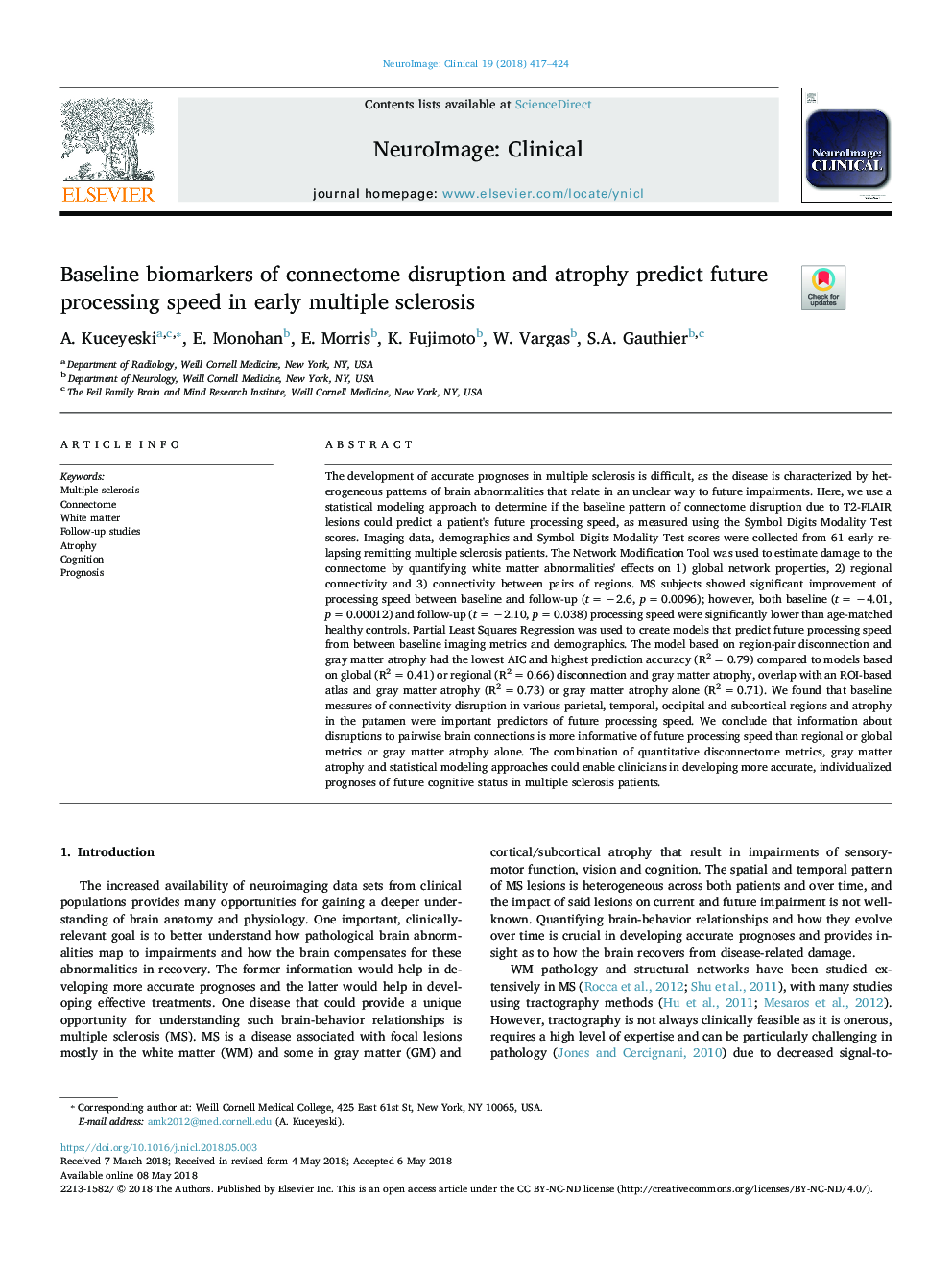| کد مقاله | کد نشریه | سال انتشار | مقاله انگلیسی | نسخه تمام متن |
|---|---|---|---|---|
| 8687676 | 1580948 | 2018 | 8 صفحه PDF | دانلود رایگان |
عنوان انگلیسی مقاله ISI
Baseline biomarkers of connectome disruption and atrophy predict future processing speed in early multiple sclerosis
ترجمه فارسی عنوان
بیومارکرهای پایه ای از اختلال اتصال و آتروفی، پیش بینی سرعت پردازش آینده در ابتدای مولتیپل اسکلروزیس را پیش بینی می کنند
دانلود مقاله + سفارش ترجمه
دانلود مقاله ISI انگلیسی
رایگان برای ایرانیان
کلمات کلیدی
موضوعات مرتبط
علوم زیستی و بیوفناوری
علم عصب شناسی
روانپزشکی بیولوژیکی
چکیده انگلیسی
The development of accurate prognoses in multiple sclerosis is difficult, as the disease is characterized by heterogeneous patterns of brain abnormalities that relate in an unclear way to future impairments. Here, we use a statistical modeling approach to determine if the baseline pattern of connectome disruption due to T2-FLAIR lesions could predict a patient's future processing speed, as measured using the Symbol Digits Modality Test scores. Imaging data, demographics and Symbol Digits Modality Test scores were collected from 61 early relapsing remitting multiple sclerosis patients. The Network Modification Tool was used to estimate damage to the connectome by quantifying white matter abnormalities' effects on 1) global network properties, 2) regional connectivity and 3) connectivity between pairs of regions. MS subjects showed significant improvement of processing speed between baseline and follow-up (tâ¯=â¯â2.6, pâ¯=â¯0.0096); however, both baseline (tâ¯=â¯â4.01, pâ¯=â¯0.00012) and follow-up (tâ¯=â¯â2.10, pâ¯=â¯0.038) processing speed were significantly lower than age-matched healthy controls. Partial Least Squares Regression was used to create models that predict future processing speed from between baseline imaging metrics and demographics. The model based on region-pair disconnection and gray matter atrophy had the lowest AIC and highest prediction accuracy (R2â¯=â¯0.79) compared to models based on global (R2â¯=â¯0.41) or regional (R2â¯=â¯0.66) disconnection and gray matter atrophy, overlap with an ROI-based atlas and gray matter atrophy (R2â¯=â¯0.73) or gray matter atrophy alone (R2â¯=â¯0.71). We found that baseline measures of connectivity disruption in various parietal, temporal, occipital and subcortical regions and atrophy in the putamen were important predictors of future processing speed. We conclude that information about disruptions to pairwise brain connections is more informative of future processing speed than regional or global metrics or gray matter atrophy alone. The combination of quantitative disconnectome metrics, gray matter atrophy and statistical modeling approaches could enable clinicians in developing more accurate, individualized prognoses of future cognitive status in multiple sclerosis patients.
ناشر
Database: Elsevier - ScienceDirect (ساینس دایرکت)
Journal: NeuroImage: Clinical - Volume 19, 2018, Pages 417-424
Journal: NeuroImage: Clinical - Volume 19, 2018, Pages 417-424
نویسندگان
A. Kuceyeski, E. Monohan, E. Morris, K. Fujimoto, W. Vargas, S.A. Gauthier,
